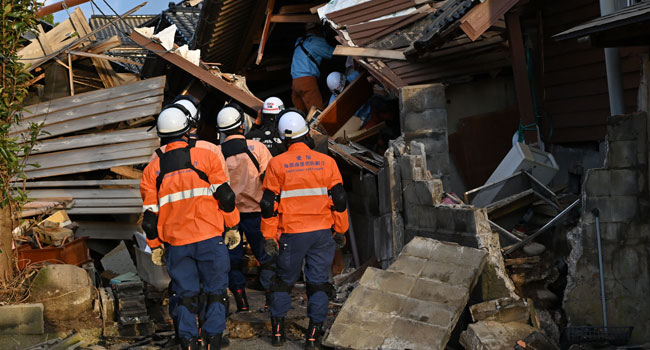At least 48 dead in Japan quake
A devastating earthquake on New Year’s Day left at least 48 people dead and caused massive destruction in Ishikawa prefecture, on Japan’s main island of Honshu.
The quake, which had a magnitude of 7.5 according to the US Geological Survey, triggered tsunami waves over a metre high, sparked a huge fire and damaged roads.
The Noto Peninsula suffered severe damage, with buildings burned, houses crushed, fishing boats wrecked or stranded, and highways blocked by landslides.
“I can’t believe the house is in such a bad shape and none of my family members got hurt,” said Akiko, who was outside her parents’ leaning house in Wajima, one of the worst-hit cities.
ALSO READ: 7.4 Magnitude Quake in Central Japan Sparks Tsunami Alert
She told AFP that the “strong and long” earthquake on Monday was something she would never forget. “It’s a terrible way to start 2024,” she said.
“It was a very intense shake,” said Tsugumasa Mihara, 73, who was waiting in line with hundreds of others for water in Shika, a nearby town.
The local authorities said the death toll was 48, but it could go up as rescue workers searched through the debris.
Prime Minister Fumio Kishida said after a meeting on the disaster response that the damage was “very extensive”, with many casualties, collapsed buildings and fires. “We have to act quickly to find and save the victims of this disaster.”
Aerial news footage showed the frightening extent of a fire that engulfed the old market area of Wajima, where a seven-storey building also fell down. The fire-fighting efforts were hampered by the damage caused by the quake.
The local power company said that nearly 33,000 households had no electricity in the area, where the temperature dropped below zero overnight. Many cities also lacked running water.
Japan’s meteorological agency said the quake had a magnitude of 7.6, and that it was one of more than 210 that shook the region until Tuesday evening.
Several powerful aftershocks were felt on Tuesday morning, including one that measured 5.6 and made the national broadcaster NHK switch to a special programme.
The presenter said, “Please calm down,” and advised viewers to check their kitchens for fires.
After a series of small tsunamis hit Wajima and other places on Monday, with waves reaching up to 1.2 metres (four feet), Japan cancelled all tsunami alerts on Tuesday as the threat of bigger waves did not materialise.
Social media images showed the devastation caused by the tremors in Ishikawa, where cars, houses and bridges shook violently and people hid in fear in shops and train stations.
Many buildings collapsed or caught fire, roads cracked or slid, and boats overturned. Rainfall could worsen the situation by loosening the soil on the hillsides, forecasters said.
In Wajima, television footage showed firefighters searching for survivors under a fallen commercial building, cutting through wooden beams with an electric saw and shouting words of encouragement.
Reports said that up to 200 structures were on fire in Wajima, and people fled in the dark, some with blankets and some with babies.
The Wajima Fire Department said they were swamped with calls for help and reports of damage on Tuesday.
On social media, Ishikawa Governor Hiroshi Hase said that landslides and cracks had severed roads in many areas, and that several vessels had capsized in the port of Suzu.
The mayor of Suzu described the city’s damage as “catastrophic” and said that 1,000 houses had been totally destroyed, leaving 4,000 to 5,000 residents homeless, according to local media.
The quake also affected Tokyo, about 300 kilometres (186 miles) away, where Emperor Naruhito’s public New Year’s Day event was called off.
About 1,400 people spent the night on halted bullet trains, including Georgia’s ambassador Teimuraz Lezhava who thanked the “kindness of the station staff and the passengers around us” on social media.
Another 1,000 people were trapped in local express trains for almost a day after they stopped on Monday, NHK reported.
Around 500 people were also stuck at the damaged airport of Noto, where the runway had cracks and the roads were blocked.
Japan is used to frequent earthquakes, most of which do no harm.
However, the number of earthquakes in the Noto Peninsula region has been rising since 2018, according to a Japanese government report last year.
The country still remembers the huge 9.0 magnitude undersea quake that struck off northeastern Japan in 2011, triggering a tsunami that killed or left missing around 18,500 people.
The disaster also flooded the Fukushima nuclear plant, causing one of the worst nuclear accidents in history.
After the latest quake, Japan’s nuclear authority said there were no problems at the Shika nuclear power plant in Ishikawa or other plants.
China joined the US and other countries in offering condolences on Tuesday.
